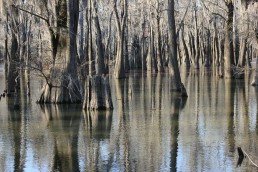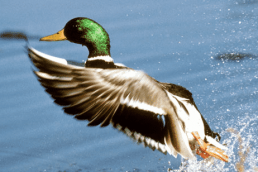Hunting Wood Ducks on your own Terms, and Turf
SHARE THIS POST
When there’s a touch of fall in the air and cold fronts start dipping, Midwesterners know what’s ahead—hunting season. Deer season usually tops the list followed closely by pheasant hunting. Then there’s fall turkey, dove, rabbit, squirrel and maybe even bear, in some states. But don’t forget about waterfowl.
Duck hunting is quickly becoming one of my favorite sports. It can be expensive, considering all the gear you need, especially if you have to pay to access good places near flyways where mallards and pintails are. There is another type of species though: wood ducks, aka woodies, squealers, acorn ducks, swamp ducks.
It won’t break the bank if you decide to go after the woodies. They’re found just about anywhere that holds a little water. If you already have hunting land or fishing spots, the chances are good that you have a place to hunt them. It doesn’t a lot of equipment either. All you need is a shotgun (handles steel shot), shells and some camo. Depending on your method, you can add a call or two and maybe half a dozen decoys.
Wood ducks fascinate me. The hens are so well camouflaged on water that they’ll spot you long before you see them. In full breeding plumage, the drake is the most beautiful duck on the planet. They’re forever wild, independent and living in their own paradise. These “squealers” as they are sometimes called have a splendid vocabulary of their own that is distinguished only as “wood duck talk.” It’s not just the allure of the wood duck that draws me; it’s the places where they live. These can be found just beyond the backyard.
Finding wood ducks
As I mentioned, your current hunting or fishing locations probably have ideal places for woodies. Any type of wetland can hold them, and they can also be found in open marshes reasonably close to forest terrain. They’ll also occasionally go into fields near water to feed on waste grain such as corn or wheat. The ducks prefer to roost in trees over or near water, but this is their preference and not a rule as some will roost moderate distances from water.
Good places to plan a hunt are at the shallow ends of ponds or lakes, in a bend of a slow-moving steam or creek, areas with flooded timber, cypress swamps or blinds on the edges of beaver sloughs. Scout these before the season on early mornings at daybreak and at sunset. Watch for roosting areas and the directions they fly at dusk and dawn. It’s not recommended to hunt in or on the edges of roosting areas, as these ducks are smart and this could ruin a good roost for the entire season.
Myths about woodies
They can’t be called in:
A lot of hunters have fallen for the fallacy that wood ducks can’t be called. I am here to tell you otherwise. In the right situation, they will come to a call just like a mallard. I have personally had many respond to my calling. The high-pitched hen call, “teeeowwwit,” or the really high-pitched drake whistle, “to-wwiit,” works well getting them in range as they’re trying to land. The same calls work if they land out of range. Call to them and they will sometimes go over or past an in-range area. Then, flush them and shoot. The loud “wheat-wheat” sound the squealers make when they’re spooked is a good call to use when they have flown over you and you’ve missed a shot opportunity. Often, they will turn for another pass.
They can’t be decoyed:
A small spread of decoys work, but keep it small. Four or six work really well. Keep the number of drake and hen decoys identical in even numbers, similar to how they would naturally travel—in pairs. A large number of decoys look unnatural because you usually don’t see large groups of woodies together. Only using two, a drake and a hen, is great for small setups. Have one decoy rigged with a weighted jerk line (string). Wood ducks rarely sit still in the water, and pulling a jerk line will create some action in the water, causing the other decoys to bob around.
Are you enjoying this post?
You can be among the first to get the latest info on where to go, what to use and how to use it!
Setups, methods for hunting
There are just a few methods of hunting wood ducks: blind hunting, pass hunting and ambushing. They are basically hunted like any other duck. It’s just that these live in more wooded habitat than other ducks. They can be found literally anywhere, and they are fast and have no problem maneuvering through timber.
Blind hunting can be very productive and it doesn’t take anything fancy. Just construct one out of whatever nature has for you nearby. Set up near the water’s edge of a slough, pond or wherever you’re hunting. Sometimes a blind isn’t even necessary if you find large enough trees to sit by and you can rely on your camo. Throw out a small spread of decoys and keep your call ready to react for them flying in or over. Be in the blind early and perform your setup well before daybreak. Woodies are notorious for landing on the water before legal shooting hours—many times I’ve had to call over the swimmers and flush them for a shot.
Pass hunting is where preseason scouting can pay off. This is a technique where hunters lie in wait for wood ducks as they fly over. Find the roosting places and the paths they take on early mornings when they leave the roost to feed and then late afternoons on their way back to roost. Set up on that flight path, no closer than a couple hundred yards from the roost. And again, never hunt too close to their roost. Woodies are predictable and will keep the same patterns until shot at a couple times, so aim true and make them count. Good places are usually creeks, streams, rivers or wood lines located between roosting areas and wetlands.
Ambushing is a traditional way many hunters go after wood ducks. The key to this is to know your hunting territory and where the woodies will be. You can hunt them all day if you choose. The ducks will be on the water or on the bank feeding on acorns, beech mast or other seeds of trees. The strategy is to slip in undetected by the ducks, and once you spot them, get in a position to make a good shot, then flush and shoot. Creeks and streams are the ideal ambush places, especially in the bends. It can be difficult to put the slip on woodies in sloughs or flooded timber because of the flat terrain that usually accompanies these. Wherever you decide to ambush, sneak in slowly—wood ducks have a keen sense of sight and sound and they also blend in well with their surroundings. And listen intently as you approach; these are very vocal ducks.
A day in the field for me
A typical day for my wood duck hunts usually starts out hunting from a blind I’ve constructed at a favorite farm pond located in the middle of big timber. It could have a beaver dam across the spillway and cypress growing on the shallow end. I hunt the shallow end with a spread of four, sometimes six decoys, with one rigged on a jerk line. I get there early because the squealers always land before shooting light. I’ll do a lot of wood duck talk early.
If there is no action, I will then head to a section of hardwoods that has a big creek running through it. I’ll try my hand at ambushing until I’m tired or it’s lunchtime. If it’s a “duck day,” I will stay and make an evening hunt, reverting to pass hunting. I like to sit beside a group of big oak trees on a field’s wood line just between a roosting area and some beaver sloughs. I will do some intermittent calling and stay ready for potential fast-flying action on the fringes.
Be aware of the limit, as it’s usually two or three daily. I would also encourage the harvest of drakes only. It’s better to let the hens go to promote conservation and ensure that our future generations will have the opportunities that we’ve had to hunt the wood ducks. Check your state regulations for licensing. You’ll need a federal Duck Stamp in addition to whatever state you’re in requires.
I love hunting these birds more than anyone else I know. It’s not the kill that keeps me coming back for more—it’s the whole package. I am drawn to wood duck territory, and they live in the most beautiful places on earth. I don’t have to get a shot on a woodie—much less bag one—to have a “successful” hunt. Sometimes I will just sit still and watch them and listen to all the different sounds they make talking to each other. It’s amazing and I always imagine how it would feel to be as wild and free as they are.
MWO
SHARE THIS POST
Did you enjoy this post?
You can be among the first to get the latest info on where to go, what to use and how to use it!
Andy Douglas
Andy Douglas is an avid hunter, outdoor writer, and photographer. He has been chasing whitetails, big toms, bass, and most game that can be had for over 35 years. He lives the outdoor lifestyle and is passionate about sharing with others through stories and photos. Email him at AndyDouglas.Outdoors@yahoo.com



